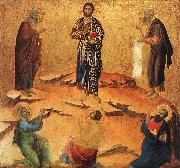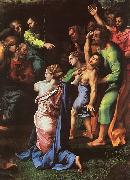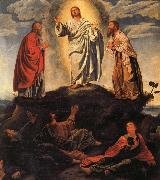
Oil On
Canvas, Real Flavor of Old Masters
|
Duccio di Buoninsegna
|
|||
|
|
|||
| 1255-1318 Italian Duccio di Buoninsegna Locations Italian painter. He was one of the most important painters of the 14th century and like his slightly younger contemporary, Giotto, was a major influence on the course of Italian painting. An innovator, he introduced into Sienese painting new altarpiece designs, a dramatic use of landscape, expressive emotional relationships, extremely complex spatial structures and a subtle interplay of colour. His most important and revolutionary work, the Maeste for Siena Cathedral, was never matched during the 14th century, if at all, and his influence lasted well into the 15th century. | |||
|
|
|||
|
|
The Transfiguration Duccio di Buoninsegna9.jpg Painting ID:: 266 Visit European Gallery |
1308-11 National Gallery, London | |
Height Width |
INS/CM |
||
|
X |
|
||
|
|
|||
|
Raphael
|
|||
|
|
|||
| Italian High Renaissance Painter, 1483-1520 Raphael Sanzio, usually known by his first name alone (in Italian Raffaello) (April 6 or March 28, 1483 ?C April 6, 1520), was an Italian painter and architect of the High Renaissance, celebrated for the perfection and grace of his paintings and drawings. Together with Michelangelo and Leonardo da Vinci, he forms the traditional trinity of great masters of that period. Raphael was enormously productive, running an unusually large workshop, and, despite his early death at thirty-seven, a large body of his work remains, especially in the Vatican, whose frescoed Raphael Rooms were the central, and the largest, work of his career, although unfinished at his death. After his early years in Rome, much of his work was designed by him and executed largely by the workshop from his drawings, with considerable loss of quality. He was extremely influential in his lifetime, though outside Rome his work was mostly known from his collaborative printmaking. After his death, the influence of his great rival Michelangelo was more widespread until the 18th and 19th centuries, when Raphael's more serene and harmonious qualities were again regarded as the highest models. His career falls naturally into three phases and three styles, first described by Giorgio Vasari: his early years in Umbria, then a period of about four years (from 1504-1508) absorbing the artistic traditions of Florence, followed by his last hectic and triumphant twelve years in Rome, working for two Popes and their close associates. | |||
|
|
|||
|
|
The Transfiguration Raphael36.jpg Painting ID:: 3317 Visit European Gallery |
The Vatican | |
Height Width |
INS/CM |
||
|
X |
|
||
|
|
|||
|
Raphael
|
|||
|
|
|||
| Italian High Renaissance Painter, 1483-1520 Raphael Sanzio, usually known by his first name alone (in Italian Raffaello) (April 6 or March 28, 1483 ?C April 6, 1520), was an Italian painter and architect of the High Renaissance, celebrated for the perfection and grace of his paintings and drawings. Together with Michelangelo and Leonardo da Vinci, he forms the traditional trinity of great masters of that period. Raphael was enormously productive, running an unusually large workshop, and, despite his early death at thirty-seven, a large body of his work remains, especially in the Vatican, whose frescoed Raphael Rooms were the central, and the largest, work of his career, although unfinished at his death. After his early years in Rome, much of his work was designed by him and executed largely by the workshop from his drawings, with considerable loss of quality. He was extremely influential in his lifetime, though outside Rome his work was mostly known from his collaborative printmaking. After his death, the influence of his great rival Michelangelo was more widespread until the 18th and 19th centuries, when Raphael's more serene and harmonious qualities were again regarded as the highest models. His career falls naturally into three phases and three styles, first described by Giorgio Vasari: his early years in Umbria, then a period of about four years (from 1504-1508) absorbing the artistic traditions of Florence, followed by his last hectic and triumphant twelve years in Rome, working for two Popes and their close associates. | |||
|
|
|||
|
|
The Transfiguration Raphael37.jpg Painting ID:: 3318 Visit European Gallery |
The Vatican | |
Height Width |
INS/CM |
||
|
X |
|
||
|
|
|||
|
Giovanni Gerolamo Savoldo
|
|||
|
|
|||
| Italian Mannerist Painter , c. 1480 - aft.1548 was an Italian High Renaissance painter. Savoldo was born in Brescia, but little is known about his early years. Some sources claim he was known as Girolamo Bresciano. By 1506 he was in Parma, and by 1508, he had joined the Florentine painter??s guild. In this period he finished the Rest at the Flight from Egypt (Augsburg), the Elijah Harassed by a Crow (National Gallery of Art, Washington), and a Deposition. In 1515 he painted the Portrait of a Clad Warrior, wrongly identified with Gaston de Foix. Also from the same period his the Temptings of St. Anthony, which appears to show the influence of the Flemish Hieronymus Bosch. The works was appreciated by the commissioners from Venice, where Savoldo relocated before 1520. On June 15, 1524 he signed a contract for an altarpiece for the church of San Domenico in Pesaro (now in the Brera, Milan). In 1527, he completed a St. Hieronymus for the Brescian family Averoldi, probably the one at National Gallery of London. From the 1530s dates a Nativity at the National Gallery in Washington DC, which seems influenced by the lambent contemporary, Correggio painting on the same topic. In 1533 Savoldo painted a Madonna with Four Saints in the church of Santa Maria in Organo, while in 1537-1538 he executed the altarpiece for the main altar of Santa Croce, Brescia. | |||
|
|
|||
|
|
The Transfiguration new3/Giovanni Gerolamo Savoldo-774565.jpg Painting ID:: 29904 Visit European Gallery |
mk67 Panel 54 3/4x495/8in Uffizi,Gallery | |
Height Width |
INS/CM |
||
|
X |
|
||
|
|
|||










